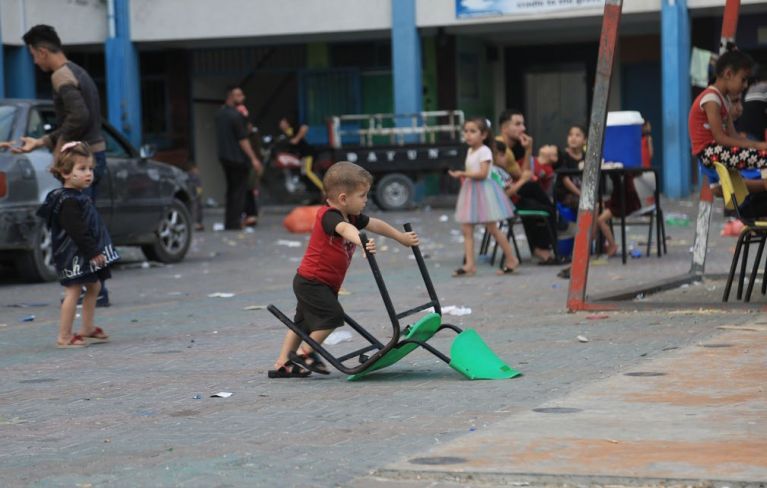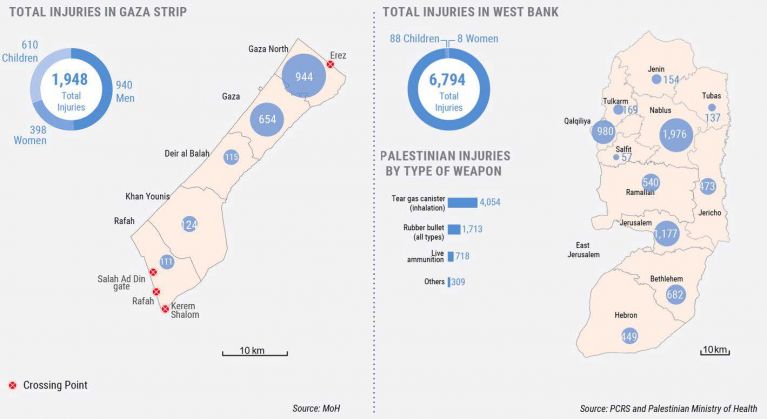Escalation in the Gaza Strip, the West Bank and Israel | Flash Update #12 covering 12:00 21 May – 12:00 23 May
- No armed hostilities have been reported since 02:00 21 May, when a ceasefire entered into effect between Israel and Palestinian armed groups in Gaza, bringing to an end the hostilities that began on 10 May.
- Routine life is being restored throughout Gaza. Some of the main roads have been made passable, and the authorities are fixing damaged electrical lines, water and wastewater networks.
- The Ministry of Health (MoH) reported that five male bodies were evacuated from under the rubble in Khan Younis in the past 48 hours, but their status has not been verified, yet.
- During the reporting period, clashes between Palestinians and Israeli forces continued across the West Bank, including East Jerusalem, resulting in 413 Palestinian injuries, including three children.
- Today, the Humanitarian Coordinator for the OPT, Lynn Hastings, announced the release of almost US$18 million from the OPT Humanitarian Fund. The Emergency Relief Coordinator in New York has allocated an additional $4 million to restore people’s access to basic services in Gaza. A consolidated inter-agency response plan, which will include a financial appeal, will be released in the coming days.
Key asks
- All sides must maintain the ceasefire.
- Israeli and Palestinian authorities must facilitate unimpeded access for humanitarian relief.
- Israeli and Palestinian authorities must launch investigations, in line with international standards, into alleged violations of international humanitarian law committed during the conduct of hostilities.
- Donors are called on to increase their funding for humanitarian interventions.
Situation overview
Casualties: Gaza and Israel
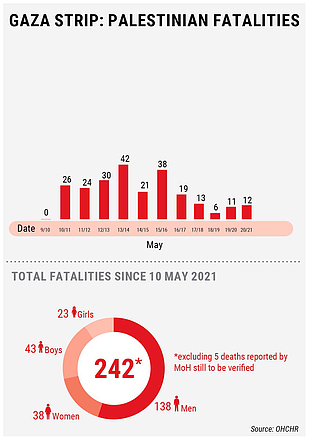 No armed incident has been reported since the ceasefire entered into effect on 21 May (as of 02:00). On 22 May, in the context of the continued ban on access to fishing off the Gazan coast, the Israeli Navy opened warning fire towards Palestinian boats off the coast of Khan Yunis. No injuries were reported.
No armed incident has been reported since the ceasefire entered into effect on 21 May (as of 02:00). On 22 May, in the context of the continued ban on access to fishing off the Gazan coast, the Israeli Navy opened warning fire towards Palestinian boats off the coast of Khan Yunis. No injuries were reported.
From 10 May up to 12:00 on 21 May, OHCHR verified that 242 Palestinians, including 66 children, 38 women (of whom four were pregnant) and 138 men, have been killed in Gaza. The overall number includes three people with disabilities, including a child. According to OHCHR, at least 129 of those killed were civilians.1 At least 230, including 62 children, were seemingly killed by Israeli forces. Some of the Palestinian casualties in Gaza may have resulted from Palestinian rockets falling short. At least 14 families in Gaza have lost three or more family members in the same incident, for a total of 77 fatalities. In the past 48 hours, five male bodies were reportedly evacuated from under the rubble in Khan Younis but their status has not been verified yet.
According to the Ministry of Health, 1,948 Palestinians were injured during the hostilities, including 610 children, 398 women (of whom three were pregnant) and 940 men.
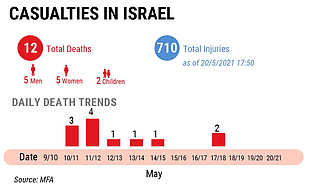 In Israel, twelve people, including one soldier and three foreign nationals, were killed during the hostilities by Palestinian rocket or other fire, or when running for shelter during such strikes. Hundreds were injured since the start of the hostilities, according to Israeli sources. According to Israeli sources, during the hostilities, Israeli forces carried out over 1,500 strikes from air, land and sea across the Gaza Strip, while Palestinian armed groups fired more than 4,000 rockets and projectiles towards Israel, with hundreds falling short within the Gaza Strip.
In Israel, twelve people, including one soldier and three foreign nationals, were killed during the hostilities by Palestinian rocket or other fire, or when running for shelter during such strikes. Hundreds were injured since the start of the hostilities, according to Israeli sources. According to Israeli sources, during the hostilities, Israeli forces carried out over 1,500 strikes from air, land and sea across the Gaza Strip, while Palestinian armed groups fired more than 4,000 rockets and projectiles towards Israel, with hundreds falling short within the Gaza Strip.
Gaza
Infrastructure and Services
Since the ceasefire, repair teams are continuing to assess and repair damage, prioritizing essential infrastructure. According to the Ministry of Public Works and Housing, from the start of the escalation until 12:00 on 20 May, 258 buildings, comprising 1,042 housing and commercial units, were destroyed. In addition, 769 housing units were severely damaged, and rendered uninhabitable. An additional 14,536 housing units suffered minor damage. Explosive ordnance disposal (EOD) police have been assessing buildings and areas struck by projectiles, and have reportedly neutralized over 150 such devices as of 20 May.
The Education Cluster verified that 54 education facilities were damaged during the escalation. The Ministry of Education (MoE) announced today that the school year will end on 3 June, with no final exams set for grades 1 to 11, except for grade 12 students who will sit for the final exam (Tawjihi). UNRWA schools remain closed, and as of now, no decision has yet been communicated regarding the end of their school year. Almost 600,000 students have had suffered a significant learning loss, in addition to the psychosocial consequences. According to the Health Cluster, six hospitals and eleven primary healthcare centres were damaged, with one centre suffering severe damage.
Water, sanitation, and electric infrastructure were severely damaged during the escalation. Although GEDCO, the electricity distribution company, has continued to work on repairing feeder lines and networks, the average daily power supply remains at five-seven hours across Gaza. The only power plant continues to work at half capacity, and will not be operational until fuel is made available. According to the WASH Cluster, the three main water desalination plants have resumed operation, but at limited capacity due to reduced availability of power supply. This has resulted in improving access to drinking water supply to 400,000 people, even if it is still irregular. Similarly, wastewater treatment facilities have resumed operation at limited capacity, reducing the daily quantity of untreated or partially treated wastewater being discharged to the sea to more than 20,000 cubic metres. All the landfills are now accessible, and solid waste and rubble are being removed from urban areas. The communication network damaged during the hostilities has been repaired. Public utilities companies declared that the shortage of spare parts and equipment is affecting the repair and maintenance of damaged networks.
Displacement
According to UNRWA, overnight 20 and 21 May, over 77,000 internally displaced persons (IDPs) were seeking protection in 58 UNRWA schools. Following the ceasefire, the vast majority have returned home with only 330 remaining as of 22 May. According to the Ministry of Social Development (MoSD), the number of people staying with host families, which reached some 36,700 by 21 May, has also significantly reduced.
Crossings
The Israeli-controlled Erez passenger crossing, which has been closed since 10 May, remains so, except for 60 international humanitarian staff and journalists allowed into Gaza on 21 May. Patients referred to medical treatment in hospitals in West Bank, including East Jerusalem, are awaiting the reopening of the crossing, as well as those who left prior to 10 May and want to return to their homes in Gaza.
The Kerem Shalom commercial crossing which has also been closed, except for a few hours on 18 May, allowed the entry of about 50 truckloads of humanitarian goods and 27 truckloads of animal fodder on 21 May. The Ministry of Agriculture declared that there is still a severe shortage of animal fodder, resulting in increasing animal deaths and a possible collapse of the sector.
The Rafah crossing and the Salah Ad Din Gate with Egypt are open as usual. Fourteen patients were transferred to Egypt through the Rafah crossing on 21 May and reportedly others today.
Access to the permissible fishing zone has not yet been allowed by Israeli forces despite the cessation of hostilities. Nevertheless, yesterday some fishermen reportedly resumed fishing within 2 nautical miles.
West Bank, including East Jerusalem
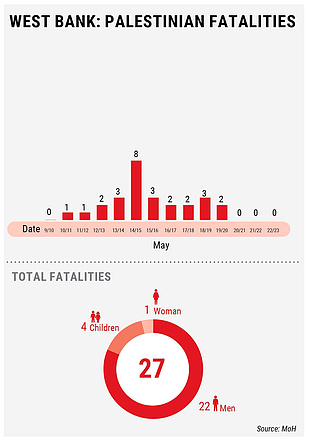 During the reporting period, tension in the West Bank, including East Jerusalem, remained high, with demonstrations and clashes between Palestinians and Israeli forces, resulting in a total of 413 Palestinians, including 3 children, injured and at least 12 arrested.
During the reporting period, tension in the West Bank, including East Jerusalem, remained high, with demonstrations and clashes between Palestinians and Israeli forces, resulting in a total of 413 Palestinians, including 3 children, injured and at least 12 arrested.
After Friday prayers on 21 May, mass-demonstrations took place across the West Bank, including East Jerusalem, in celebration of the Gaza ceasefire and in solidary with the families at imminent risk of eviction in Sheikh Jarrah in East Jerusalem. Clashes were reported between Palestinians and Israeli forces in various locations, including in the Al Aqsa compound and at Damascus and Herod gates in the Old City of Jerusalem.
On 22 May, during the daily protests in Sheikh Jarrah by Palestinians, Israeli and foreign activists against Israel’s eviction policy in East Jerusalem and the ongoing closure of the Al Jaouni area, Israeli forces physically assaulted and injured three Palestinians, including a boy. Israeli forces also carried out multiple search-and-arrest operations, mainly in the northern West Bank, arresting at least 14 Palestinians.
On 22 May, Israeli settlers set fire to field crops and uprooted dozens of olive trees in two herding communities in southern Hebron, and physically assaulted Palestinians in the Israeli controlled are of Hebron city. Since 22 April, OCHA has documented nearly 70 attacks resulting in Palestinian casualties or damage, almost double the monthly average of incidents in the first quarter of 2021 and in the previous three years. In these incidents, two Palestinians were killed and at least 50 injured by Israeli forces intervening after Israeli settlers raided villages and clashed with Palestinians, and more than 20 were directly injured by Israeli settlers. During the same period, 25 Israelis, including two children, have been injured due to stone throwing by Palestinians when travelling on West Bank roads, according to Israeli sources.
Since 10 May, 27 Palestinians have been killed and 6,794 injured by Israeli forces across the West Bank in protests, clashes and attacks. Of all the injuries recorded, about 60 per cent required medical treatment after inhaling tear gas, 25 per cent were hit by rubber bullets and 11 per cent were shot with live ammunition.
Notes
1. Those reported as civilians are individuals who are not members of armed forces and were not directly participating in hostilities at the time that they were killed. Whether an individual is qualified as civilian or not, has no bearing on the legality of the killing. Data is based on information from at least three independent and reliable sources at the time of reporting. As further verified information becomes available, the number of fatalities in total, and in any of the categories, may change.
Humanitarian response & ongoing needs
Protection
Gaza: Based on data from the national helpline, operated by Protection Cluster partners, there is a continuous increase of Mental Health and Psychosocial Support (MHPSS) needs for parents and children, particularly on how to help children who suffer from trauma, fear and panic following 11 days of bombings. Partners are scaling up the national helpline to include more operators due to the increase and severity of calls. Operators are reporting high fatigue and need of MHPSS support themselves. MHPSS and wellbeing sessions are daily provided to staff responding to Gender-Based Violence (GBV) in Gaza.
West Bank, including East Jerusalem: Cluster partners are monitoring and documenting cases of suspected violations of international law, and providing legal aid and child protection services, as well as MHPSS. Of ongoing concern is the suspected excessive use of force by Israeli forces, including live ammunition shot at against protesters and in clashes, including during search and arrest operations. This raises a serious concern of arbitrary arrests and detention and violations of the freedom of expression and assembly. Cluster partners continue to provide remote MHPSS and legal aid for those detained, particularly to children and Human Rights Defenders. Partners are recording an increasing demand for legal aid as the frequency of suspected violations related to arrests and detentions, settler violence, excessive use of force and access restrictions is increasing. Cluster partners are reporting an increased risk of violence against children by Israeli forces and Israeli settlers. Children attending schools located near Israeli settlements are of particular risk, subsequently undermining their access to education. Partners are scaling up the national helpline to include more operators due to increase and severity of calls. Operators are reporting high levels of fatigue and need of MHPSS support themselves. Major constraints reported by cluster partners include movement restrictions, risk of being attacked while helping people, as well as gaps in human resources, such as Psychosocial Support (PSS) workers. Partners are providing support to Community-Based Organizations (CBO) to provide MHPSS emergency services in their communities, in addition to activate neighborhood watch-mechanisms to ensure protection against settler violence. MHPSS awareness raising material is being disseminated.
Health
Gaza: Six hospitals and 11 primary healthcare centres were damaged in the hostilities, including one that sustained severe damage. The Health Cluster is carrying out assessments of health facilities, specifically focusing on emergency services’ capacity and other essential services to inform both short and long term needs.
West Bank, including East Jerusalem: During the reporting period, emergency medical services attended people who were wounded in clashes across the West Bank, including East Jerusalem. They remain on standby.
Shelter
Gaza: Partners are assessing the damage and supporting the repair of homes, giving priority to vulnerable groups. According to the Ministry of Social Development (MoSD), 3,222 families comprising 16,612 people had their homes damaged during the hostilities. According to the Ministry of Public Work and Housing, between 10 and 20 May, some 258 buildings, comprising 1,042 housing and commercial units, were destroyed. In addition, 769 units were severely damaged, and rendered uninhabitable. An additional 14,536 units suffered minor damage.
Water, Sanitation and Hygiene (WASH)
Gaza: Water and sanitation infrastructure sustained severe damage during the hostilities: some 93 strikes damaging WASH infrastructure were recorded. Wastewater networks, pipelines, sewage evacuation vehicles, water wells, a wastewater pumping station and other services were severely damaged. The three main water desalination plants are now operating with limited capacities, due to the power shortage, leaving some 400,000 people without regular water supply. While the Gaza Coastal Municipality Water Utility (CMWU) is operating the wastewater plants at limited capacity, more than 20,000 cubic metres of untreated water is being discharged daily into the sea due to damage caused to Gaza governorate's main sewer pressure pipeline.
Education
Gaza: Since 10 May, some 54 education facilities, including 46 schools, three kindergarten, one UNRWA vocational education centre, two Ministry of Education (MoE) directorate buildings and the premises of the Islamic University were damaged due to the hostilities, with reports indicating that a number were directly hit by airstrikes or tank shells. On 23 May, the MoE in Gaza announced that the school year will end on 3 June, with no final exams set for grades 1 to 11i). The preparations for the final exam (Tawjihi) for twelve-grade students will continue. The Education Cluster has deployed an assessment team to verify and assess the needs of the damaged schools and kindergartens in Gaza and to share an initial report of the needs with all relevant stakeholders.
West Bank, including East Jerusalem: According to the Education Cluster, all schools in the West Bank, including East Jerusalem, are open as of 23 May.
Food Security
Gaza: The poultry and livestock sectors risk complete collapse due to the severe shortage of fodder. MoA reports an increased death of birds, while sheep and cattle breeders are coping by l feeding the animals less, compromising production. As of 23 May, the World Food Programme (WFP) has supported about 100,000 people affected by the crisis. On 23 May, WFP will assist 318 IDPs still present at two UNRWA shelters with food. On 21 May, WFP distributed 4,571 parcels (about 13,713 kg) of fresh bread to families affected by the conflict, through its 200 WFP-contracted local shops. WFP’s cash-based voucher electronic platform is accessible for humanitarian agencies to use and provide non-food and other basic assistance to affected persons. The Gaza Protection Consortium will be delivering immediate multi-purpose cash assistance to 1,000 families particularly affected by the hostilities, starting with households in Gaza City and North Gaza governorates. WFP is also ascertaining road impact to ensure safe staff movement and predict possible issues in commodity movement.
